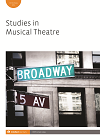-
f Special Issue: Dance in musical theatre
- Source: Studies in Musical Theatre, Volume 13, Issue 1, Mar 2019, p. 3 - 7
-
- 01 Mar 2019
- Previous Article
- Table of Contents
- Next Article
Abstract
This special issue of Studies in Musical Theatre examines the role of dance in musical theatre from a variety of perspectives. Given the scholarly turn from textual analysis to performance analysis, even studying musicals without extensive dance per se can benefit from understanding how movement shapes meaning. The introduction below explains some key themes that have emerged in the six articles that follow. One is the question of genre: what exactly is musical theatre dance? Another is auteurship: what is the role of the choreographer in shaping musicals? A third is technology, which reminds readers that choreography extends beyond human bodies. Finally, the articles all consider questions of methodology and history – how do we best study musical theatre? While there are several other areas of potential inquiry not covered in these six articles, this special issue, the first in the field to focus on dance in musical theatre, aims to help define and cohere an important subfield.



